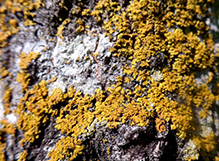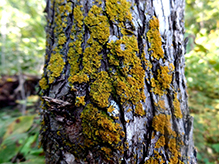Candleflame Lichen
(Candelaria concolor)
Conservation • Description • Ecology • Distribution • Taxonomy
|
|
||||||||||||||
Description |
Candleflame Lichen, also called Lemon Lichen, is a small, very widespread, very common, foliose lichen. It occurs worldwide on all continents, including Antarctica. It occurs throughout the United States, but it is most common east of the Great Plains, and it is absent from the Great Basin. Candleflame Lichen is found in a wide variety of habitats. It is common in young well-lit forests, but it is less common in mature forests with a dense canopy. It is very tolerant of pollution and is common in urban and suburban areas. When it is the dominant lichen species in an area it is an indication of high nitrogen in the environment. It grows mostly on nutrient-rich bark of trees, especially on maple, ash, willow, and elm. It also grows on debarked wood, fence posts, and walls. It is less common on rock. The fruiting body is small, less than ⅜″ (1 cm) in diameter, and cushion-like (suborbicular). Adjacent fruiting bodies often merge to form a large mass. The vegetative body (thallus) is leaf-like (foliose) and divided into small, loosely overlapping lobes. The lobes are flattened, about ⅜″ (1 cm) long, and 1⁄128″ to 1⁄64″ (0.5 to 1.0 mm) wide. The upper surface may be flat, wavy, or raised, fan-like. It is lemon yellow to orangish yellow when exposed to the sun, pale to yellowish green in the shade. The margins are finely scalloped. Cortex-free areas of the thallus (soralia), appearing as horizontal, crescent-shaped slits on and near the margins or at the tips of the lobes, produce granular clusters of cells (soredia). The lower surface is white to pinkish. It is held to the substrate by scattered, unbranched, white, root-like structures (rhizines). Disk-like, spore-producing structures (apothecia) are rare. When present, they are 1⁄128″ to 1⁄64″ (0.5 to 1.0 mm) in diameter. The disk is the color of the thallus but darker. The margin is smooth at first, becoming uneven and granular with age. |
Similar Species |
|
Ecology |
Substrate |
Trees |
Growth Form |
Foliose |
Habitat |
Well-lit young forests, urban and suburban areas. |
Hosts |
|
Distribution |
||
|
Sources |
|
| 1/18/2025 | ||
Occurrence |
||
Very common and widespread |
||
Taxonomy |
|
Kingdom |
Fungi (Fungi) |
Subkingdom |
Dikarya |
Phylum |
Ascomycota (Sac Fungi) |
Subphylum |
Pezizomycotina (Sac Fungi and Lichens) |
Class |
Candelariomycetes (Lichinomycetes?) |
Subclass |
Candelariomycetidae (obsolete?) |
Order |
Candelariales |
Family |
Candelariaceae |
Genus |
Candelaria (candleflame lichens) |
Mycobiont |
Candelaria concolor |
Photobiont |
|
Class The move has been widely but not universally accepted. ITIS, MycoPortal, NatureServe, and iNaturalist place Candelariales in the class Lichinomycetes. Index Fungorum, MycoBank, LichenPortal, GBIF, and Catalog of Life place it in the class Candelariomycetes. |
|
Subordinate Taxa |
|
|
|
Synonyms |
|
Blasteniospora concolor Caloplaca concolor Caloplaca laciniosa Candelaria concolor Candelaria concolor f. citrina Candelaria concolor var. concolor Candelaria concolor var. effusa Candelaria concolor var. stellata Candelaria vulgaris f. citrina Candelariella concolor Lecanora concolor Lecanora laciniosa Lichen concolor Lobaria concolor Parmelia parietina f. concolor Parmelia parietina var. concolor Physcia concolor Physcia parietina var. concolor Physcia parietina var. laciniosa |
|
Common Names |
|
Candleflame Lichen Elfin Candleflame Lichen Lemon Lichen |
|
Glossary
Apothecium
An open, disk-shaped or cup-shaped, reproductive structure, with spore sacs on the upper surface, that produces spores for the fungal partner of a lichen. Plural: apothecia.
Foliose
Leaf-like; referring to lichens with thin, flat, leaf-like growths divided into lobes which are free from the substrate.
Rhizine
A root-like structure of a lichen that attaches the lower layer to the substrate.
Soralium
On lichens, an area on the thallus with no cortex, usually on or near the margin or the tip of a lobe, on which soredia are produced. Plural: soralia.
Soredium
An asexual reproductive structure of a lichen in the form of a tiny dull granule on the thallus surface that can be easily brushed off. It consists of a cluster of algal cells (the photobiont) wrapped in fungal filaments (the mycobiont), but without an outer layer of protective tissue (cortex). Plural: soredia.
Thallus
In lichens: The vegetative body of a lichen composed of both the alga and the fungus. In liverworts: a flat, relatively undifferentiated plant body. Plural: thalli.
Visitor Photos |
||
Share your photo of this lichen. |
||
This button not working for you? |
||
Luciearl |
||
MinnesotaSeasons.com Photos |
||
|
|
|
|
|
|

Slideshows |
|

Visitor Videos |
||
Share your video of this lichen. |
||
This button not working for you? |
||
|
Other Videos |
||
Candelaria concolor, lichens of Ouray Colorado USA |
About
Aug 9, 2020 I am saying it wrong... |
Candelaria concolor, Xanthoria parietina |
About
Mar 3, 2021 |
Lemon lichen, Candelaria concolor, North Tampa, Florida. |
About
Oct 28, 2022 This might be one of the most common lichens in the US. Typically found on bark. |

Created: 1/18/2025 Last Updated: © MinnesotaSeasons.com. All rights reserved. |




